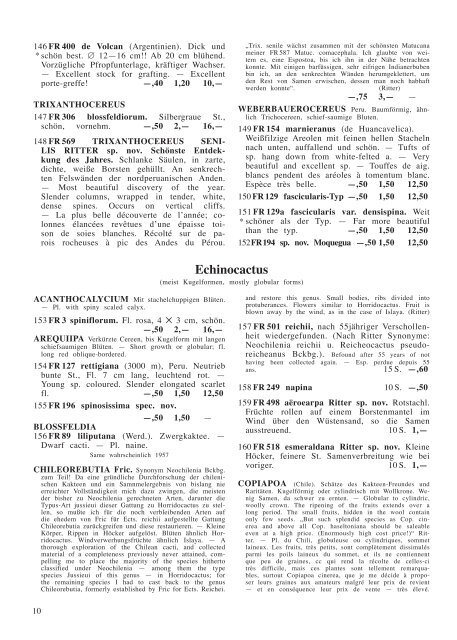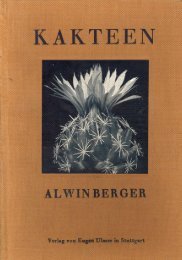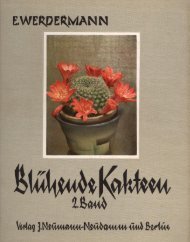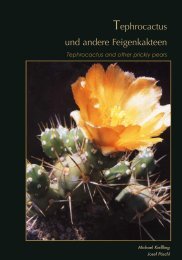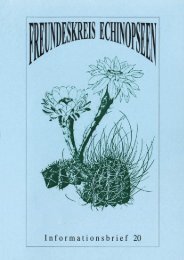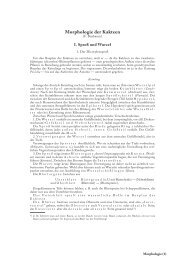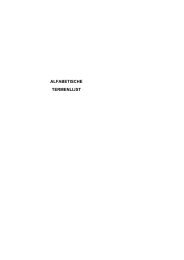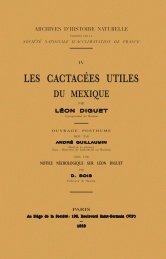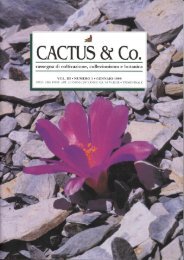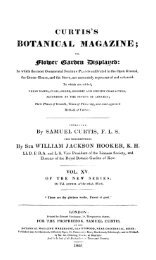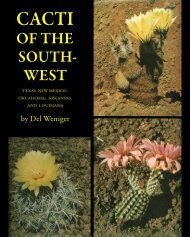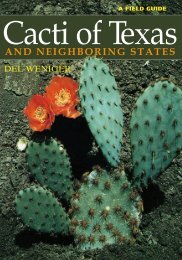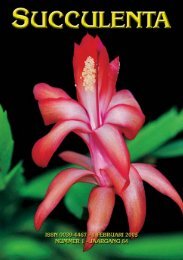H. WINTER - Bibliothèque numérique d'ouvrages sur les cactus et ...
H. WINTER - Bibliothèque numérique d'ouvrages sur les cactus et ...
H. WINTER - Bibliothèque numérique d'ouvrages sur les cactus et ...
Sie wollen auch ein ePaper? Erhöhen Sie die Reichweite Ihrer Titel.
YUMPU macht aus Druck-PDFs automatisch weboptimierte ePaper, die Google liebt.
146 FR 400 de Volcan (Argentinien). Dick und<br />
* schön best. ∅ 12—16 cm!! Ab 20 cm blühend.<br />
Vorzügliche Pfropfunterlage, kräftiger Wachser.<br />
— Excellent stock for grafting. — Excellent<br />
porte-greffe! —,40 1,20 10,—<br />
TRIXANTHOCEREUS<br />
147 FR 306 blossfeldiorum. Silbergraue St.,<br />
schön, vornehm. —,50 2,— 16,—<br />
148 FR 569 TRIXANTHOCEREUS SENI-<br />
LIS RITTER sp. nov. Schönste Entdeckung<br />
des Jahres. Schlanke Säulen, in zarte,<br />
dichte, weiße Borsten gehüllt. An senkrechten<br />
Felswänden der nordperuanischen Anden.<br />
— Most beautiful discovery of the year.<br />
Slender columns, wrapped in tender, white,<br />
dense spines. Occurs on vertical cliffs.<br />
— La plus belle découverte de l’année; colonnes<br />
élancées revêtues d’une épaisse toison<br />
de soies blanches. Récolté <strong>sur</strong> de parois<br />
rocheuses à pic des Andes du Pérou.<br />
„Trix. senile wächst zusammen mit der schönsten Matucana<br />
meiner FR 587 Matuc. comacephala. Ich glaubte von weitem<br />
es, eine Espostoa, bis ich ihn in der Nähe b<strong>et</strong>rachten<br />
konnte. Mit einigen barfüssigen, sehr eifrigen Indianerbuben<br />
bin ich, an den senkrechten Wänden herumgekl<strong>et</strong>tert, um<br />
den Rest von Samen erwischen, dessen man noch habhaft<br />
werden konnte“.<br />
(Ritter)<br />
—,75 3,— —<br />
WEBERBAUEROCEREUS Peru. Baumförmig, ähnlich<br />
Trichocereen, schief-saumige Bluten.<br />
149 FR 154 marnieranus (de Huancavelica).<br />
Weißfilzige Areolen mit feinen hellen Stacheln<br />
nach unten, auffallend und schön. — Tufts of<br />
sp. hang down from white-felted a. — Very<br />
beautiful and excellent sp. — Touffes de aig.<br />
blancs pendent des aréo<strong>les</strong> à tomentum blanc.<br />
Espèce très belle. —,50 1,50 12,50<br />
150 FR 129 fascicularis-Typ —,50 1,50 12,50<br />
151 FR 129a fascicularis var. densispina. Weit<br />
* schöner als der Typ. — Far more beautiful<br />
than the typ. —,50 1,50 12,50<br />
152 FR 194 sp. nov. Moquegua —,50 1,50 12,50<br />
Echino<strong>cactus</strong><br />
(meist Kugelformen, mostly globular forms)<br />
ACANTHOCALYCIUM Mit stachelchuppigen Blüten.<br />
— Pl. with spiny scaled calyx.<br />
153 FR 3 spiniflorum. Fl. rosa, 4 ✕ 3 cm, schön.<br />
—,50 2,— 16,—<br />
AREQUIIPA Verkürzte Cereen, bis Kugelform mit langen<br />
schiefsaumigen Blüten. — Short growth or globular; fl.<br />
long red oblique-bordered.<br />
154 FR 127 r<strong>et</strong>tigiana (3000 m), Peru. Neutrieb<br />
bunte St., Fl. 7 cm lang, leuchtend rot. —<br />
Young sp. coloured. Slender elongated scarl<strong>et</strong><br />
fl. —,50 1,50 12,50<br />
155 FR 196 spinosissima spec. nov.<br />
—,50 1,50 —<br />
BLOSSFELDIA<br />
156 FR 89 liliputana (Werd.). Zwergkaktee. —<br />
Dwarf cacti. — Pl. naine.<br />
Same wahrscheinlich 1957<br />
CHILEOREBUTIA Fric. Synonym Neochilenia Bckbg.<br />
zum Teil! Da eine gründliche Durchforschung der chilenischen<br />
Kakteen und ein Samnmelergebnis von bislang nie<br />
erreichter Vollständigkeit mich dazu zwingen, die meisten<br />
der bisher zu Neochilenia gerechn<strong>et</strong>en Arten, darunter die<br />
Typus-Art jussieui dieser Gattung zu Horrido<strong>cactus</strong> zu stellen,<br />
so mußte ich für die noch verbleibenden Arten auf<br />
die ehedem von Fric für Ects. reichii aufgestellte Gattung<br />
Chileorebutia zurückgreifen und diese restaurieren. — Kleine<br />
Körper, Rippen in Höcker aufgelöst. Blüten ähnlich Horrido<strong>cactus</strong>.<br />
Windverwerhungsfrüchte ähnlich Islaya. — A<br />
thorough exploration of the Chilean cacti, and collected<br />
material of a compl<strong>et</strong>eness previously never attained, compelling<br />
me to place the majority of the species hitherto<br />
classified under Neochilenia — among them the type<br />
species Jussieui of this genus — in Horrido<strong>cactus</strong>; for<br />
the remaining species I had to cast back to the genus<br />
Chileo rebutia, formerly established by Fric for Ects. Reichei.<br />
and restore this genus. Small bodies, ribs divided into<br />
protuberances. Flowers similar to Horrido<strong>cactus</strong>. Fruit is<br />
blown away by the wind, as in the case of Islaya. (Ritter)<br />
157 FR 501 reichii, nach 55jähriger Verschollenheit<br />
wiedergefunden. (Nach Ritter Synonyme:<br />
Neochilenia reichii u. Reicheo<strong>cactus</strong> pseudoreicheanus<br />
Bckbg.). Befound after 55 years of not<br />
having been collected again. — Esp. perdue depuis 55<br />
ans. 15 S. —,60<br />
158 FR 249 napina 10 S. —,50<br />
159 FR 498 aëroearpa Ritter sp. nov. Rotstachl.<br />
Früchte rollen auf einem Borstenmantel im<br />
Wind über den Wüstensand, so die Samen<br />
ausstreuend. 10 S. 1,—<br />
160 FR 518 esmeraldana Ritter sp. nov. Kleine<br />
Höcker, feinere St. Samenverbreitung wie bei<br />
voriger. 10 S. 1,—<br />
COPIAPOA (Chile). Schätze des Kakteen-Freundes und<br />
Raritäten. Kugelförmig oder zylindrisch mit Wollkrone. Wenig<br />
Samen, da schwer zu ernten. — Globular to cylindric,<br />
woolly crown. The ripening of the fruits extends over a<br />
long period. The small fruits, hidden in the wool contain<br />
only few seeds. „But such splendid species as Cop. cinerea<br />
and above all Cop. haseltoniana should be saleable<br />
even at a high price. (Enormously high cost price!)“ Ritter.<br />
— Pl. du Chili, globuleuse ou cylindriques, somm<strong>et</strong><br />
laineux. Les fruits, très p<strong>et</strong>its, sont complètement dissimulés<br />
parmi <strong>les</strong> poils laineux du somm<strong>et</strong>, <strong>et</strong> ils ne contiennent<br />
que peu de graines, cc qui rend la récolte de cel<strong>les</strong>-ci<br />
très difficile, mais ces plantes sont tellement remarquab<strong>les</strong>,<br />
<strong>sur</strong>tout Copiapoa cinerea, que je me décide à proposer<br />
leurs graines aux amateurs malgré leur prix de revient<br />
— <strong>et</strong> en conséquence leur prix de vente — très élevé.<br />
10


